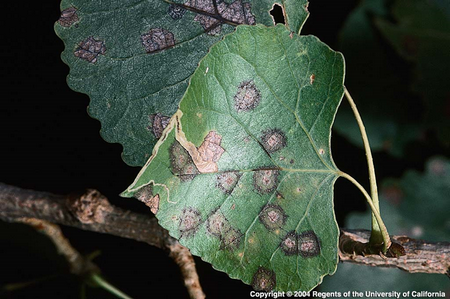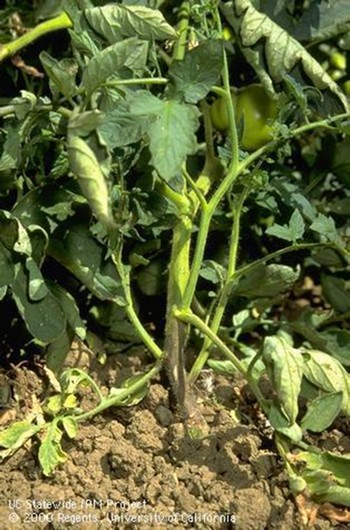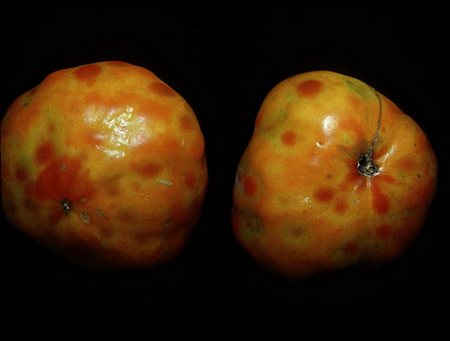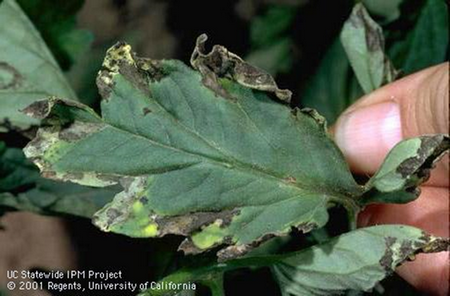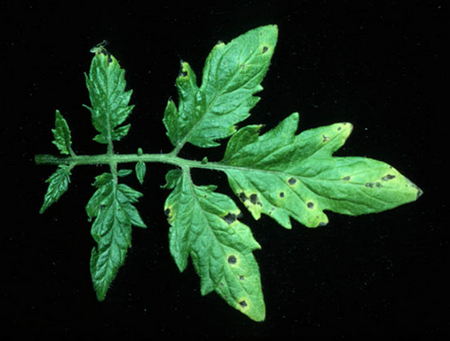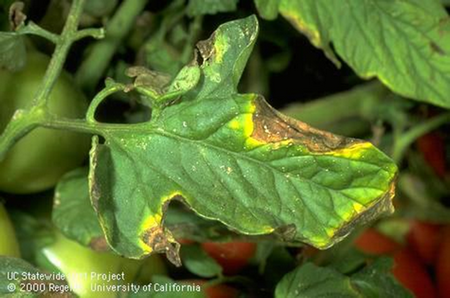Tomato Diseases in the Home Garden
As tomato growers, we might consider any ailing tomato to have a disease. That would end up making this blog post really, really long. However, we need to consider diseases separately from damage done by pests (both vertebrate and invertebrate—see blog post from July 18: Tomato Diseases in the Home Garden) or environmental disorders such as blossom end rot (see blog post from July 4: https://ucanr.edu/blogs/blogcore/postdetail.cfm?postnum=57297). We will cover fungal, viral, and bacterial diseases here.
Fungal
The most common tomato diseases are fungal. Many of these fungal spores are nearly everywhere all the time, and given the right conditions, will find a home on your tomato plants. Some fungi prefer cool conditions while some prefer warm. Most prefer wetness and high humidity. Crowding can prevent proper air circulation and encourage fungal diseases. Nutritional deficiencies and injuries also encourage fungal diseases.
Damping Off Disease typically affects seedlings. It's caused by various soil fungi that grow under damp conditions. The affected tap roots of seedlings in contaminated, overly damp soil are dark and mushy and the seedlings usually die. Prevent this by using fresh clean soil and sanitized containers with good drainage. Use alcohol or a 10% bleach solution to sanitize. https://ipm.ucanr.edu/PMG/PESTNOTES/pn74132.html
Septoria Leaf Spot is favored when plants are exposed to cool, rainy weather or splashing from soil. It's relatively uncommon in Contra Costa County. Prune off infected leaves and twigs and keep plants dry. https://ipm.ucanr.edu/PMG/GARDEN/PLANTS/DISEASES/septorialfspot.html
Phytophthora Root and Crown Rot is a soil-borne fungus-like organism transmitted under wet conditions by splashing water or contaminated garden debris, pots, or tools. Plants appear drought-stressed since the vascular system is compromised, and often die. It can also cause damping-off. Look for darkening of the crown, roots, and stems. Good drainage, avoiding overwatering, and sanitizing any tools used on the diseased plants are preventive measures. In previously affected soil, avoid planting members of the Solanaceae family (tomatoes, eggplant, peppers, potatoes) in the infected soil and plant a resistant crop instead such as corn. https://ipm.ucanr.edu/PMG/PESTNOTES/pn74133.html
White Mold, also called Cottony Soft Rot, appears as bleached areas on stems from white mycelia. Fruit can be affected and appears gray. The mold favors hot, moist conditions and often spreads from dying flowers. Bury or dispose of infected tissue; avoid overhead watering, overwatering, and crowding. https://ipm.ucanr.edu/PMG/GARDEN/VEGES/DISEASES/tomwhmold.html
Powdery Mildew looks different on artichoke, pepper, and tomato leaves from its appearance on other plants (see reference). It requires warm weather and living tissue to grow but does not require moist conditions. Prevention includes planting resistant varieties in sunny areas and avoiding crowding. Occasionally a fungicide or a biologic is needed. https://ipm.ucanr.edu/PMG/PESTNOTES/pn7406.html
Early Blight's name is somewhat misleading as it occurs on mature tomato plants and can affect fruit. It is uncommon in our Mediterranean climate. See reference for photos, prevention, and treatment: https://ipm.ucanr.edu/PMG/GARDEN/VEGES/DISEASES/tomearlyblight.html
Late Blight (Phytopthora infestans) occurs in our coastal areas and is favored by average temperatures and high humidity. It can spread rapidly from other Solanaceae family members or their cullings. Avoid overhead sprinkling and crowding of plants and buy certified blight-free seeds and tubers. Dispose of affected plants and debris in green waste. https://ipm.ucanr.edu/PMG/GARDEN/VEGES/DISEASES/lateblight.html
Black Mold typically affects ripe tomato fruit during conditions of warmth and high humidity. It can appear as small dark brown spots or grow into large, sunken areas. Pick fruit as soon as it ripens. https://ipm.ucanr.edu/PMG/GARDEN/VEGES/DISEASES/tomblkmold.html
Verticillium and fusarium wilt are fungal diseases that will be discussed in an upcoming blog.
Viral
Tobacco Mosaic Virus is a disease primarily of Solanaceae, of which tobacco is a member. It is transmitted by infected seeds or by tobacco residue on the hands of smokers. The leaves appear mottled and stringy, but the fruit is edible. Herbicide damage can appear similar. Many tomato cultivars have resistance. https://ipm.ucanr.edu/PMG/GARDEN/VEGES/DISEASES/tobaccomosvir.html
Curly Top Virus and Spotted Wilt Virus are fairly unusual afflictions. Curly Top Virus is carried by the beet leafhopper and causes curling, puckering, and stunting of leaves. Fruit is usually discolored and small. Spotted Wilt Virus is transmitted by the western flower thrip. It can be difficult to diagnose as it presents differently depending on the stage of plant growth. Fortunately, it's rare in Contra Costa County. Both have wide host ranges. For severe infections in the garden, testing may be warranted since the viruses can mimic other diseases. Affected plants will need to be removed and disposed of. Unfortunately, insecticides do not kill thrips or leafhoppers in time once the damage has been noticed. https://ipm.ucanr.edu/PMG/GARDEN/VEGES/DISEASES/curlytop.html
https://ipm.ucanr.edu/PMG/GARDEN/VEGES/DISEASES/tomspotwltvir.html
Bacterial
Bacterial Speck, Bacterial Spot, and Bacterial Canker are all easily confused. They tend to be introduced on infected seeds, and can overwinter on garden debris, flats, and stakes. They all prefer wet conditions. All three cause lesions on fruit. Speck and Spot cause similar leaf lesions and are chiefly distinguished by their appearance on fruit.
Bacterial Speck prefers cooler conditions such as in coastal regions. A Pseudomonas bacterium causes small sunken spots with white halos that can become scabby. The leaf spots are similar and appear greasy, and leaf margins can turn brown in an angular pattern. Stems can also be affected.
Bacterial Spot is caused by Xanthomonas bacteria, resulting in large, black, sunken spots on fruit and irregular black spots on leaves. Warm, humid conditions favor its appearance. The fruit may be eaten once the black spots and any underlying maceration are removed. https://u.osu.edu/vegetablediseasefacts/tomato-diseases/bacterial-leaf-spot/basics/
Bacterial Canker also prefers warm, humid conditions. Stunting, wilting, scorching of leaf margins, cankers on stems, and vascular discoloration are distinguishing features.
https://ucanr.edu/blogs/blogcore/postdetail.cfm?postnum=27926&postnum=27926
Bacterial diseases can be managed somewhat with copper sprays and these sprays are acceptable for organic farming.
Prevention
Prevention is the ideal way to manage all these diseases:
• Rotate crops
• Don't overwater or spray the plant
• Don't crowd plants
• Remove lower leaves that can touch the soil
• Use mulch to prevent spread from soil
• Buy resistant varieties
• Control weeds to prevent thrip and leafhopper invasions
• Dispose of infected plant parts and debris, sanitize tools, planting flats, and hands
• Baby heirloom tomatoes because they typically have little resistance
For more information about pests and diseases of tomatoes, see this website: https://ipm.ucanr.edu/home-and-landscape/tomato/index.html
Help Desk of the UC Master Gardeners of Contra Costa County (EAS)

